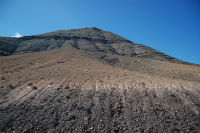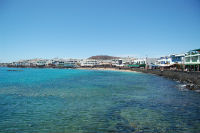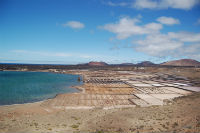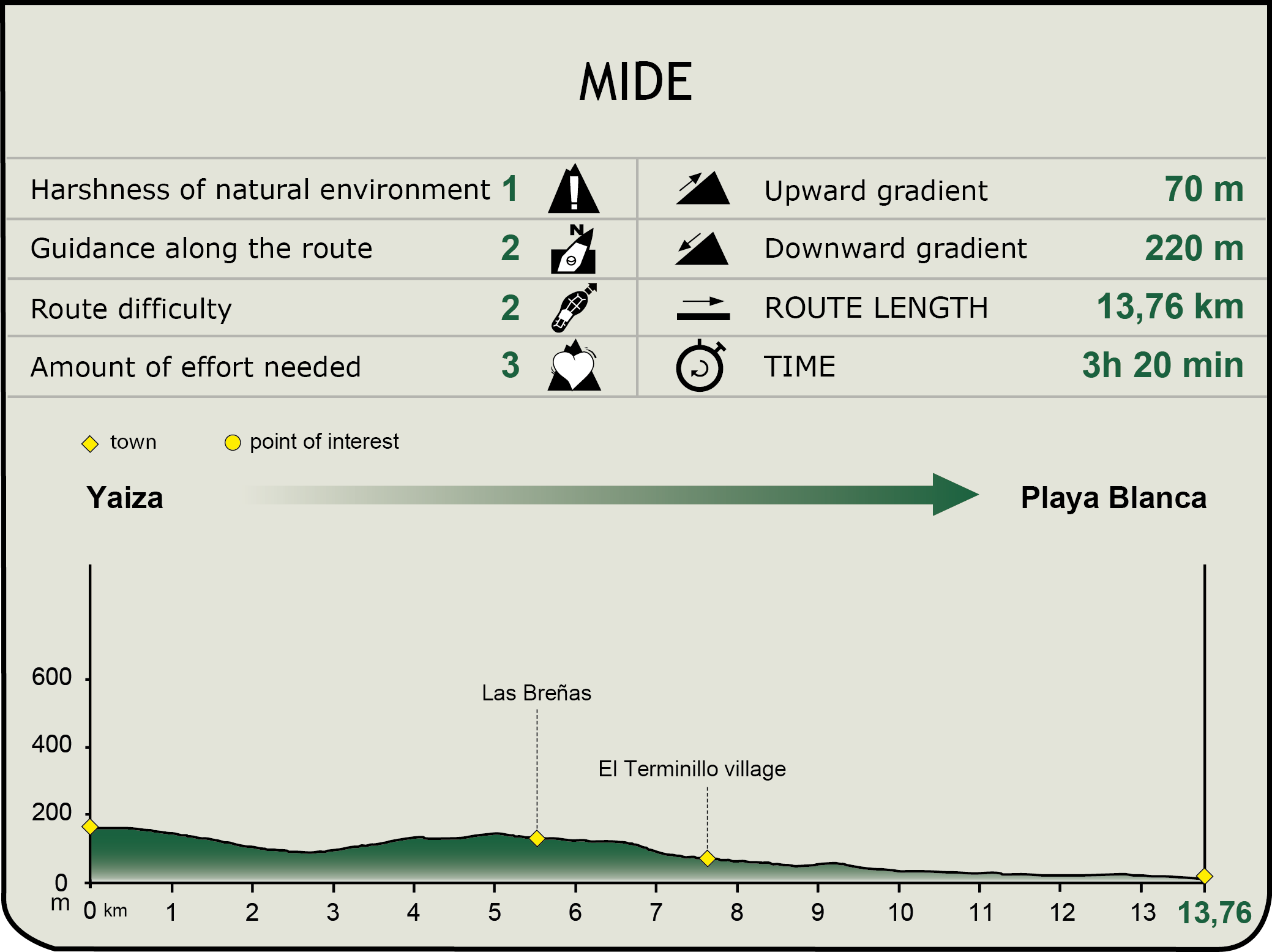- Home
- Rural Development
- Nature Trails
- Nature Trails
- Canary Islands Sector
- Órzola a Playa Blanca
Stage 5: Yaiza-Playa Blanca
Description

The trail descends from Yaiza and after passing Las Breñas, the traveller will be able to see the endpoint in Playa Blanca
Yaiza is the starting point of the fifth and last stage of this Órzola-Playa Blanca Nature Trail. The trail leaves the town going down and guarded by the Cinta mountain and the LZ-701 road. This only ascent ends entering the town of Las Breñas, from where the endpoint of the stage and Fuenteventura island can be seen. From Las Breñas, the traveller begins a pleasant downhill slope, in which the Poblado del Terminillo stands out. The trail continues going down until it reaches the beautiful coastal town of Playa Blanca, where the traveller ends this spectacular nature trail.

The last stage of the Órzola-Playa Blanca Nature Trail begins in the town of Yaiza, specifically in Vista de Yaiza Street. The trail goes down through this street and turns left climbing through some stone stairs, after which the trail turns right through a wide dirt path.
The traveller goes down between the LZ-701 road to the right and the Cinta mountain to the left and gets near kilometre 60, where the trail goes up through a stretch ending near kilometre 61.
The trail becomes a narrow path again and then it goes up. Later on, it reaches kilometre 62, where there is a cattle farm and the trail becomes wider again. After a few metres going down through a dirt path, the traveller enters the town of Las Breñas using the road for more than 1,500 m, so we recommend maximum caution.

The trail reaches the city centre and goes down taking a path to the right through calle La Hoya. Following the signals, the traveller wanders down the town and shortly, before kilometre 4, the trail leaves the paved path and the city centre. It leaves a cattle farm on the right and becomes a narrow path before reaching the Poblado del Terminillo, where numerous architectural remains have been found, the main ones being the rocks inscriptions and accurately engraved stones.
The trail continues slightly downwards, permitting the traveller to see Playa Blanca and Fuerteventura island. After passing kilometre 67, the trail goes into a wide dirt path, leaving a farm to the left. A few metres further, the path goes to the right and enters a Special Protection Area for birds, where the Canarian houbara or Houbara bustard (Chlamydotis undulata) is the main protagonist.

Shortly before kilometre 68, the trail becomes a wide dirt path that leaves the first urbanization of Playa Blanca to the right. Later on, the trail takes a narrow path that ends at avenida A. Femés. The traveller goes through that avenue until the trail passes kilometre 70 and reaches a small roundabout where it goes straight ahead. Shortly after, the trail reaches the roundabout that links with LZ-2 road and it turns left at calle El Varadero. The trail goes down this street, reaching the end of this fifth stage of the Órzola-Playa Blanca Nature Trail, at the interpretative display panel located in Limones St. The traveller will be able to enjoy all the services and beaches the privileged location of this nature trail endpoint offers.
Sites of interest
Profile

MIDE (Method for the Information of Excursions)
Featured
Further information
Yaiza
It is a municipality located in the south of Lanzarote island. This region was known as el Rubicón and here started the European conquest of the archipelago. The cathedral of San Marcial de Limoges was built there, as well as the first European settlement in 1402. The municipality has 11 urban areas and Yaiza is located in the limits of the area covered by the volcanic eruptions occurred between 1730 and 1736. The parish priest of Yaiza, Mr. Andrés Lorenzo, wrote the most detailed chronicles of these volcanic eruptions. The city council of this town is located opposite to the church of Nuestra Señora de los Remedios, which is the patron saint of this municipality. Her festivities are celebrated on the 8th of September. Its economic activity is based on tourism and agriculture.
Salt flats of Janubio
They were declared Site of Cultural Interest of Janubio by Law 12/1987, of 19 June, on Natural Areas in the Canary Islands. They are the largest salinas of Lanzarote island and were constructed in a lake that appeared after the volcanic eruptions occurred between 1730 and 1736. Before these eruptions and according to the Minutes of the City Council of 1653, this region had an intense port industry. The construction started in 1895 and was finished in 1945 by the Lleó family. At first, it was linked to fisheries, salting and the canning industry; however, nowadays the salt extraction is its only activity. The unquestionable landscape and environmental value of this region is worth a visit, since the Órzola-Playa Blanca Nature Trail passes by the Salinas de Janubio.